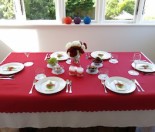Whether you are the lucky person hosting Christmas dinner this year or not, chances are your fridge will be filled to almost overflowing over Christmas and New Year. Sometimes I think we are frightened the shops will never open again after Christmas, judging by the food buying frenzy we all seem to go on.
Food safety is important throughout the whole year. However over summer and during the holiday time when we try to squeeze more into our fridges it becomes even more critical.
At this time of the year dishing up a dose of unwanted food poisoning can be even easier than at other times of the year. With careful planning and good food handling techniques this does not need to be the case.
If you are a traditional person you may be considering serving turkey for Christmas day. Making sure that your beautiful bird is properly handled at all stages of the preparation and cooking is essential.
It is very important to ensure your turkey is thoroughly thawed before cooking. This helps ensure that during cooking the temperature at the core of the bird reaches the right temperature for a safe length of time.
Thawing a turkey is not a quick job! Plan for it and allow time for this to happen properly.
Thawing your turkey at room temperature is NOT recommended at all. Thawing at room temperature takes too long, increasing the risk of food poisoning. At room temperature, bacteria on the turkey can grow rapidly when the outside portion of the bird begins to thaw. These bacteria multiply to dangerously high levels producing toxins that cooking may not destroy.
For complete safety the best method is to thaw your turkey in the fridge. Check out any thawing instructions on the package. If none are given allow about 10-12 hours per kilogram. This means you may need to allow three to four days for this process. Make sure that the turkey is stored at the bottom of the fridge and place it in a suitable container so that no juices can leak out onto other foods.
Once safely thawed make sure you cook the turkey thoroughly. Just like chicken you need to make sure the meat is thoroughly cooked in the centre this means it should be steaming hot all the way through to the centre of the bird. There should be no blood and the juices should run clear. Usually cooking instructions will be on the packet and it may come with a pop out probe which will tell you when it is cooked. But you still need to allow for ample time. Generally for every 500 grams allow 30 minutes at 180 C.
It is not uncommon to have leftovers with a turkey. Unless you are planning to cater for a crowd the next day keep your leftovers to a minimum by choosing the most appropriate size bird for your needs. A 2.5 – 3.5 kg bird serves a round 6-10 people, 3.5kg – 5kg serves 10-15 and a 10-15 kg bird serves 15-20 people.
If you do have leftovers make sure that you get them into the fridge within 2 hours of cooking. Bacterial growth after two hours increases rapidly. Store leftovers covered in the fridge. If you have a large amount leftover cool it in several smaller containers to speed up the cooling down process.
Before Christmas it is a good idea to clean out your fridge ensuring there is plenty of room for either thawing meats safely or storing leftovers. A fridge that is packed to the gunnels does not work as efficiently. Pushing our refrigerators to their limits means the cold air cannot circulate as easily in an over stocked fridge. If we cannot store food safely then the risk of contamination, from a range of food-borne bacteria, increases.
Whether you are serving turkey or not at this Christmas take with all food handling as you want your family and guests to enjoy a healthy happy festive season.






